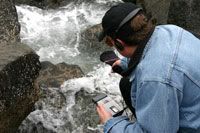It's completely true that whenever musicians get together, conversations often begin, 'I did this gig once...' followed by a tale excerpted from the many mishaps that have occurred whilst on the road. I have to say that it's all delivered with relish – somehow, it's generally acknowledged that these personal disasters just increase your general ability to cope. A kind of 'If it doesn't kill you, it's making you stronger' philosophy.
Well, I've had some experiences on the road that I wouldn't care to repeat in any great hurry. The worst were definitely way back in the mists of time when I was still working in a semi-pro dance band. I won't mention the name of the group just in case you were in the audience one night and are still bearing a grudge...
Anyway, we arrived at a venue one night and asked if there was somewhere we could change. We were trying hard, you see, and actually took different clothes to change in to for our time on stage. In my case – and remember please that this was the 1970s – my stage apparel consisted of white Levi jeans (which might have even been flared) and some sort of groovy T-shirt with, ahem, cowboy boots. Yes, I know: I have since sought help.
In any case, the manager of the 'joint' directed us to the gents' toilet as a place we could use as a dressing room. I think a couple of us went to get ready while I went to set up my gear. When my bandmates came out they warned me to be careful when I went in to change because the floor was 'very wet'. Now I won't go into detail about what the exact composition of the liquid on the floor was, but I'm thinking that your imagination can probably do a fine job.
So I had to change into these tight jeans (look, I was going through my Jeff Beck period, ok?) and boots whilst standing on a toilet so I didn't accidentally transfer any of the floor's 'wetness' to my clothes. I believe I drove home still wearing the white Levi's that night, not wishing to repeat the experience of the high wire balancing act I'd had to endure earlier.
So what exactly did I learn from this experience? Well, the next time we played that venue, I left the cowboy boots at home and took a pair of wellies instead...
Blog by UK acoustic guitarist, author and journalist David Mead covering all things guitar-related
Visit my website: www.DavidMead.net
Tuesday, 29 December 2009
Friday, 18 December 2009
Number One Or Number Two?
I should think that just about everyone who gives a damn knows about the controversy surrounding this year's Crizmuz number one: will it be Joe McElderry or Rage Against The Machine? The pro-RATM campaigners on Facebook want to make a stand against the predictability of another of 'Simon Cowell's X Factor karaoke puppets' taking the slot, but is it a point that's actually worth making?
Before the dreaded X Factor came along Crizmuz number ones were always a mix of saccharine-laden sentimental hogwash or ludicrous kiddie songs and I don't think anyone took them at all seriously apart from the record companies who were, as usual, thankful just to see their profits soar. Then, when Cowell took over, the whole thing became organised like a military operation – the X Factor final is always positioned just before Crizmuz and, after three months of intense TV exposure, the winner is generally a dead cert to take the top slot. It's sheer marketing genius; let's face it, with that kind of exposure, just about anything could be number one – and Simon Cowell says that the Facebook crowd are being 'cynical'? I would have said that it's more 'mischievous' than anything else and if the Facebook anarchists are successful then it might prove that not everyone likes being manipulated. But it will be a short-lived victory – the whole thing is set to be even larger next time around; for 2010 I hear that Cowell has his eyes on an internet campaign with an X Factor final in a stadium somewhere...
So even if this year's battle is successful, I don't think it's a winnable war, in the long term, to be honest...
Before the dreaded X Factor came along Crizmuz number ones were always a mix of saccharine-laden sentimental hogwash or ludicrous kiddie songs and I don't think anyone took them at all seriously apart from the record companies who were, as usual, thankful just to see their profits soar. Then, when Cowell took over, the whole thing became organised like a military operation – the X Factor final is always positioned just before Crizmuz and, after three months of intense TV exposure, the winner is generally a dead cert to take the top slot. It's sheer marketing genius; let's face it, with that kind of exposure, just about anything could be number one – and Simon Cowell says that the Facebook crowd are being 'cynical'? I would have said that it's more 'mischievous' than anything else and if the Facebook anarchists are successful then it might prove that not everyone likes being manipulated. But it will be a short-lived victory – the whole thing is set to be even larger next time around; for 2010 I hear that Cowell has his eyes on an internet campaign with an X Factor final in a stadium somewhere...
So even if this year's battle is successful, I don't think it's a winnable war, in the long term, to be honest...
Friday, 4 December 2009
The Boyle Effect
I have to say that I greeted the news that Susan Boyle's CD has set records for mega-sales on both sides of the Atlantic with a broad smile. Why? Well, people who know me well would fight each other to be the first to tell you that I'm not at all optimistic, generally speaking; but I think that this phenomenon might just send a very important message out to record companies and music moguls alike...
The message would read something like this... You can create boy bands, girl bands and airbrushed teen divas (of both sexes) all you like, but every so often the public is going to come face-to-face with raw talent and find that it's actually superior to your short-term media sensations in almost every respect.
If it is indeed true that the public gets the music industry that it deserves then surely Susan's success – not only as a performer but as a fully saleable entity – has got to represent some kind of turning point? I've said before how I miss the innocence of the 1960s and early 1970s where anybody could get into a band as long as they had the required talent to play their instrument to an acceptable level. It didn't matter what you looked like or even how many years you had on the clock – if you were good, you were in!
When I interviewed Eric Clapton for Guitarist magazine back in 1994 I asked him what it was like to be a musician in rock's formative years and he told me: "Well, anybody that had any idea of how to play any instrument could just about hold their own because there was no competition - there was no one around. There were only a handful of bands, and anyone that could play Sam and Dave was OK. When I started out, Stax and Motown were in the clubs and anyone who could play those songs, any drummer who could play that feel, or anyone who could approach that, was a master."
Doesn't that sound like a healthier music scene to you? The only filters were talent and dedication rather than the whims of music industry tzars with their eyes set on another get rich quick gambit.
Realistically, I don't expect the industry to change overmuch – but if Ms Boyle's success makes them think a bit it will be enough for me.
The message would read something like this... You can create boy bands, girl bands and airbrushed teen divas (of both sexes) all you like, but every so often the public is going to come face-to-face with raw talent and find that it's actually superior to your short-term media sensations in almost every respect.
If it is indeed true that the public gets the music industry that it deserves then surely Susan's success – not only as a performer but as a fully saleable entity – has got to represent some kind of turning point? I've said before how I miss the innocence of the 1960s and early 1970s where anybody could get into a band as long as they had the required talent to play their instrument to an acceptable level. It didn't matter what you looked like or even how many years you had on the clock – if you were good, you were in!
When I interviewed Eric Clapton for Guitarist magazine back in 1994 I asked him what it was like to be a musician in rock's formative years and he told me: "Well, anybody that had any idea of how to play any instrument could just about hold their own because there was no competition - there was no one around. There were only a handful of bands, and anyone that could play Sam and Dave was OK. When I started out, Stax and Motown were in the clubs and anyone who could play those songs, any drummer who could play that feel, or anyone who could approach that, was a master."
Doesn't that sound like a healthier music scene to you? The only filters were talent and dedication rather than the whims of music industry tzars with their eyes set on another get rich quick gambit.
Realistically, I don't expect the industry to change overmuch – but if Ms Boyle's success makes them think a bit it will be enough for me.
Wednesday, 18 November 2009
If You Go Down To The Woods Today...
We're probably all aware about the various campaigns across our planet to conserve and preserve nature and most of them are absolutely right and proper. However, some, fighting under the general banner 'save the rainforests', are, methinks, taking things a tad too far...
In case you hadn't heard, the Gibson guitar corporation – arguably one of the most famous makers of musical instruments in the world – was raided yesterday by the feds; and they were looking for... wood. Yep, wood. Now, I admit that I don't know the ins and outs of this particular instance, but I gather that it revolves around whether some Madagascan rosewood the company are (allegedly) using was imported legally. It's a grey area, apparently, as the Madagascan forests are of prime concern to conservationists, but the country's new president seems to have upset the apple-cart by proclaiming the export of this very sought-after wood perfectly legal. Or something. I'm not really here to speculate on this case in particular, more the clamp down on the use of so-called 'naughty wood' in the manufacture of guitars in general.
I've watched from a distance as the whole debate of what you can and can not use as a bodywood these days has raged and, somewhat predictably, turned into a bureaucratic mess of muddled thinking. Fair enough, let's stop the illegal cutting down of trees in South America by legislating against its use in furniture and musical instruments – but what about instruments that were made well before the conservationists began to raise the red flag? I personally own an instrument which contains Brazilian Rosewood – the naughtiest of all naughty woods – but it was cut down prior to 1941 and I have a certificate to prove it. Trouble is it's only effective in Europe. If I want to take the guitar to the US I have to apply for a certificate so that I can get the guitar through customs without having it seized – and that takes 90 days, apparently. The onus is on the owner to prove that the wood used in his or her instrument is legal and, as you can imagine, that's a tough call in many instances.
The interesting thing is that violinists, cellists, viola and double bass players all use bows made from a very rare and extremely naughty wood (pernambuco from Brazil) and at first, the 'wood police' were on standby to pounce on any unsuspecting orchestra's string section with sap-lust in their eyes. Trouble is, they were outnumbered and, realising that they would have to seize virtually every single bow on the planet, decided to give this particular wood immunity. Not fair, right?
So, your 1958 Martin Dreadnought with Brazilian rosewood back and sides will be impounded unless you can prove that the guy who cut the tree it was made from had legal rights to do so, but the symphony orchestra walks straight through customs without a care. See what I mean about a bureaucratic mess?
It needs sorting... soon. Guitar manufacturers are doing their bit by sourcing sustainable woods but vintage and 'old wood' guitars are never going to go away and so they need some sort of agreement here, too. And what are the wood police going to do with all their impounded instruments? Burn them? It makes me shudder to think about it...
In case you hadn't heard, the Gibson guitar corporation – arguably one of the most famous makers of musical instruments in the world – was raided yesterday by the feds; and they were looking for... wood. Yep, wood. Now, I admit that I don't know the ins and outs of this particular instance, but I gather that it revolves around whether some Madagascan rosewood the company are (allegedly) using was imported legally. It's a grey area, apparently, as the Madagascan forests are of prime concern to conservationists, but the country's new president seems to have upset the apple-cart by proclaiming the export of this very sought-after wood perfectly legal. Or something. I'm not really here to speculate on this case in particular, more the clamp down on the use of so-called 'naughty wood' in the manufacture of guitars in general.
I've watched from a distance as the whole debate of what you can and can not use as a bodywood these days has raged and, somewhat predictably, turned into a bureaucratic mess of muddled thinking. Fair enough, let's stop the illegal cutting down of trees in South America by legislating against its use in furniture and musical instruments – but what about instruments that were made well before the conservationists began to raise the red flag? I personally own an instrument which contains Brazilian Rosewood – the naughtiest of all naughty woods – but it was cut down prior to 1941 and I have a certificate to prove it. Trouble is it's only effective in Europe. If I want to take the guitar to the US I have to apply for a certificate so that I can get the guitar through customs without having it seized – and that takes 90 days, apparently. The onus is on the owner to prove that the wood used in his or her instrument is legal and, as you can imagine, that's a tough call in many instances.
The interesting thing is that violinists, cellists, viola and double bass players all use bows made from a very rare and extremely naughty wood (pernambuco from Brazil) and at first, the 'wood police' were on standby to pounce on any unsuspecting orchestra's string section with sap-lust in their eyes. Trouble is, they were outnumbered and, realising that they would have to seize virtually every single bow on the planet, decided to give this particular wood immunity. Not fair, right?
So, your 1958 Martin Dreadnought with Brazilian rosewood back and sides will be impounded unless you can prove that the guy who cut the tree it was made from had legal rights to do so, but the symphony orchestra walks straight through customs without a care. See what I mean about a bureaucratic mess?
It needs sorting... soon. Guitar manufacturers are doing their bit by sourcing sustainable woods but vintage and 'old wood' guitars are never going to go away and so they need some sort of agreement here, too. And what are the wood police going to do with all their impounded instruments? Burn them? It makes me shudder to think about it...
Thursday, 5 November 2009
Studio Log: Days Three and Four
I need to fill in a bit of background to this studio log entry. Bear with me!
Sometimes a composition takes years to come to maturity. A long time ago, I'm guessing that it would be around three years ago, I went over to the studio to record some music that I hoped to punt to an agency who deals with film music. One of the compositions I took with me back then proved too hard to 'let go'; I felt it had a bit more life to it than to see it spend its days waiting for a director to pick it up and use it for some anonymous purpose. I came over all possessive, y'see...
So when I knew I was recording a new CD, I immediately thought of this particular tune and how I should seize the opportunity to at last give it wings and let it fly. But its metamorphosis wasn't quite done, because when I said I wanted to use it, producer Martin Holmes said he thought I should play it on classical guitar as per the original session and not on steel string as I had intended. The thing is, I've been playing the tune on steel string for the past three years or so and so I had got used to hearing it that way, but Martin's major point of reference was those original sessions.
Now, never let it be said that I don't respond to ideas and so I practised the piece on nylon string (an Admira Elena-E) and went over to the studio to record it. It turns out that Martin was right; the fragility and vulnerability that the classical guitar brings to the piece breathes new life into it.
So far so good, but there was another element on those original sessions. Back then, I was in the studio with a double bass player called Ken Knussen, someone I've known since we were at school together. We both had professional music in our sights back then but Ken went into classical music and is now a very busy freelance player. So I called Ken and he was able to fit a session for me into his incredibly hectic schedule.
We haven't mixed the recording yet, but it's safe to say that the piece which has the working title 'Come Find Me' has changed yet again, Ken's bass offering another dimension, not to mention a new counter-melody.
I'm wrestling with the idea of expanding it still further by adding strings, but we're adopting an 'acoustic only' policy and so it's quite likely that we'll be wrangling some faded-in guitar chords to sound like a violin section instead.
I think it will sound grand and can't wait to get back over to the studio to add the final touches.
Sometimes a composition takes years to come to maturity. A long time ago, I'm guessing that it would be around three years ago, I went over to the studio to record some music that I hoped to punt to an agency who deals with film music. One of the compositions I took with me back then proved too hard to 'let go'; I felt it had a bit more life to it than to see it spend its days waiting for a director to pick it up and use it for some anonymous purpose. I came over all possessive, y'see...
So when I knew I was recording a new CD, I immediately thought of this particular tune and how I should seize the opportunity to at last give it wings and let it fly. But its metamorphosis wasn't quite done, because when I said I wanted to use it, producer Martin Holmes said he thought I should play it on classical guitar as per the original session and not on steel string as I had intended. The thing is, I've been playing the tune on steel string for the past three years or so and so I had got used to hearing it that way, but Martin's major point of reference was those original sessions.
Now, never let it be said that I don't respond to ideas and so I practised the piece on nylon string (an Admira Elena-E) and went over to the studio to record it. It turns out that Martin was right; the fragility and vulnerability that the classical guitar brings to the piece breathes new life into it.
So far so good, but there was another element on those original sessions. Back then, I was in the studio with a double bass player called Ken Knussen, someone I've known since we were at school together. We both had professional music in our sights back then but Ken went into classical music and is now a very busy freelance player. So I called Ken and he was able to fit a session for me into his incredibly hectic schedule.
We haven't mixed the recording yet, but it's safe to say that the piece which has the working title 'Come Find Me' has changed yet again, Ken's bass offering another dimension, not to mention a new counter-melody.
I'm wrestling with the idea of expanding it still further by adding strings, but we're adopting an 'acoustic only' policy and so it's quite likely that we'll be wrangling some faded-in guitar chords to sound like a violin section instead.
I think it will sound grand and can't wait to get back over to the studio to add the final touches.
Thursday, 29 October 2009
Giving In To McMusic?
I just thought I'd air something that's been bugging me for a couple of weeks...
Reading how a daily newspaper dubbed one of the starlets in that dodgy firmament called 'pop music' as being 'brave' because she sang one verse of her new single (and mimed to the rest) live on TV recently was enough to induce a diva-sized rant from me and several of my brothers in arms. But this was just a single incident; surely the insidious practice of allowing artists to mime in a so-called 'live' situation has gone far enough?
I have friends who have turned up to gigs where they have been booked to support some of pop's finest only to find that there are absolutely no facilities which would allow them to plug in and play. In other words, miming is dangerously near to being accepted as the norm, in pop circles at least. What's more, the public (bless 'em) don't seem to feel in the slightest short changed by the fact that they have bought a concert ticket – not cheap, by anyone's standards – in order to listen to a pre-recorded performance.
And the Musicians' Union are sorta being quiet about it, too. Sure, they make the occasional growling noise, but never seem to actually bite.
I guess all this self-righteous indignation on my part comes from the fact that I know loads of people who put in many hours practising and working incredibly hard to gain their chops in order to go in front of an audience and play. They overcome nervousness and fear – stage fright, if you will – in order to do the job they love and wouldn't dream of taking the easy avenue by resorting to the artifice of let's pretend.
I don't see a resolution on the horizon, either; not while people are prepared to accept McMusic instead of true artistry...
OK. Rant over.
Reading how a daily newspaper dubbed one of the starlets in that dodgy firmament called 'pop music' as being 'brave' because she sang one verse of her new single (and mimed to the rest) live on TV recently was enough to induce a diva-sized rant from me and several of my brothers in arms. But this was just a single incident; surely the insidious practice of allowing artists to mime in a so-called 'live' situation has gone far enough?
I have friends who have turned up to gigs where they have been booked to support some of pop's finest only to find that there are absolutely no facilities which would allow them to plug in and play. In other words, miming is dangerously near to being accepted as the norm, in pop circles at least. What's more, the public (bless 'em) don't seem to feel in the slightest short changed by the fact that they have bought a concert ticket – not cheap, by anyone's standards – in order to listen to a pre-recorded performance.
And the Musicians' Union are sorta being quiet about it, too. Sure, they make the occasional growling noise, but never seem to actually bite.
I guess all this self-righteous indignation on my part comes from the fact that I know loads of people who put in many hours practising and working incredibly hard to gain their chops in order to go in front of an audience and play. They overcome nervousness and fear – stage fright, if you will – in order to do the job they love and wouldn't dream of taking the easy avenue by resorting to the artifice of let's pretend.
I don't see a resolution on the horizon, either; not while people are prepared to accept McMusic instead of true artistry...
OK. Rant over.
Tuesday, 13 October 2009
Another Day, Then...

Yesterday was another day spent at the recording studios for my new album – and it turned out to be a bit of an epiphany...
Let's begin at the beginning. I was booked into 'The Holmestead' (as it is called) to record a track with the working title 'Lullaby' with my producer and engineer Martin Holmes at the controls. For this I had taken the guitar that the tune had been written on, a Yamaha LLX500C. Now this is the guitar that I used to record my previous CD 'Nocturnal' in full, with the exception of one track where I used an Admira classical guitar. In other words, I had the fullest confidence in it to do a fine job.
After the usual span of time we always spend faffing about with microphones and making sure that I am 'studio-proof' which means that I have to empty my pockets of everything that might jingle or jangle and show up on mic and I also have to take off my watch because the wristband makes the occasional noise as I move my hand. (Add to this the fact that I have to remember not to wear anything with zips, buttons or rivets and it's a little like going through airport security! But it's all in the name of art...)
After the traditional inaugural mug of tea, we set about going for the first take and I think we both sensed that something wasn't quite 'right'. The last time I was over at the studio we recorded a video of another track (see blog entry below) and it had been easy; after about four takes we had it in the can. But 'Lullaby' was proving a bit difficult to get down. I knew it was an awkward piece to play in certain sections – I have this nasty habit of writing things that stretch my technique a little, but that's how you progress, isn't it?
After one of those takes where just about everything that can go wrong actually did, we decided to adjourn for coffee and a chat. I said that it shouldn't happen that you can record a track in a problem-free single take despite the added pressure of knowing that the whole thing was going down on video like we did with 'Unseen Sunlight' and yet have trouble with the next piece where silly little glitches were showing up all over the place.
Now, I know that it's a bad workman who blames his tools, but the only real difference between this and the previous session was the guitar I was using. For the video I used a Fylde Falstaff – surely it can't make that much difference? Or can it? We decided to do some checks and sure enough, when we compared the sound of the two guitars, there's no doubt that the Fylde sounds much better than the LLX – in fact I think both Martin and I were both a little shocked by how much difference there was. Even listening back to a raw, unmixed take that I did a while ago, the Fylde sounded like vintage Rioja and there was no way we were going to be able to achieve that necessary consistency of sound without using it exclusively for the rest of the sessions.
I think the thing we both previously noticed as being 'wrong' was simply the fact that there was something lacking in the quality of sound and it was affecting my performance. In the act of struggling so hard to get a good sound out of the Yamaha, I was losing my 'vision' of the piece as a whole and making stupid rookie mistakes as a result.
So we decided to throw in the towel and cancel the session with the intention of using the Fylde when we resume recording. It means I have to re-learn around six pieces on a different guitar – which doesn't sound like too much of a big deal, but the Fylde has a wider fretboard and so all the pieces will need a little re-orienteering. Then we should be good to go and I think the album will sound 100% better as a result. The proof, of course, will be what happens at the next session...
Watch this space!
Monday, 5 October 2009
The Silver Screen...
As a sort of sequel to September's 'Making The Video' blog, I thought I'd follow through and actually provide a link to the finished article.
Now it has to be said that anything you upload to You Tube has to go through a process of compression imposed by the site itself which has the effect of mashing the quality of both audio and picture. The video itself was shot in hi-def and the audio recorded at DVD resolution – 24bit 96dB – and consequently a humungous size. But by the time it's been through the masher, it's a relatively small file, but a lot of the original finesse has been somewhat pished away!
Of course I'm being defensive! Anyway, here's the video to 'Unseen Sunlight' – enjoy!
Wednesday, 23 September 2009
Inspiration: Where Do You Find It?
I've always been fascinated by the idea of where exactly the idea for a song begins. I've had the great fortune to speak to many great songwriters over the years and have often asked if such-and-such a composition can be traced back to its origins – and frustratingly, the answer is usually the same: no one knows!

I'll give you an example; when I interviewed Pink Floyd's David Gilmour for Guitarist magazine a few years ago, I asked him about 'Shine On You Crazy Diamond' and he told me that the song began with the band jamming in a rehearsal studio and the famous four note 'chime' just 'falling out of my guitar...'. Apparently something in those four notes reminded Roger Waters of their fallen son, Syd Barrett and a piece of prog history began to form then and there.
Singer-songwriter James Taylor insists that he is merely a conduit for his songs and that they come from somewhere outside him, whilst other people I've spoken to will go from the mundane 'it started with a collision of two chords and then the hard work began to turn that idea into a whole piece' to the mystical 'I literally woke up one morning with the melody complete in my head. I don't know how it got there...'
Possibly the most humorous comment was from Peter Frampton, talking about one particularly inspired day of songwriting: 'I wrote 'Show Me The Way' in the morning and 'Baby I Love Your Way' just as the sun was setting... I'm still trying to work out what I had for breakfast!'
For my own part, I've just returned from a week in Cornwall and naturally I took a guitar with me (I'm finishing some pieces for my new album and so I can't afford to be sans guitar for too long at present). One morning a whole middle section of a composition I've been working on just happened; I just played it, whole and complete like I'd known it all my life – and I'll be darned if I can put into words what kind of cerebral process brought it into being. One thing I suspect was that with views from our rented cottage like this one...

...it's actually hard not to be inspired!
Thursday, 10 September 2009
Studio Log: Day Two – Making The Video...
It might seem a bit of an odd thing to do: making a video of a track before the actual recording sessions for the album itself have actually started. But my rationale was two fold:
1) Why not?
2) Never underestimate the power of You Tube
So off to the studio this morning in order to sit on a stool in front of a hi-def video camera to shoot some footage for a new composition of mine called 'Unseen Sunlight'.
Now, for the technically-minded, the video was shot 'live'; that is to say that I was actually playing and not miming to a backing track as is the norm in a lot of promotional videos you see online. It's a case of 'what you see is what you get' with this video. So this means that we didn't record the audio via the camera, rather it was picked up by two mics and the direct signal from my Headway FEQ pick-up inside the Fylde Falstff guitar and sent off to a hard disk via some unfathomable electronics. Video and audio will be synced by some more studio magic in the mixing suite later on.
The two mics serve an obvious purpose – stereo audio; but we also include some of the direct feed from the piezo in the mix so that the bass 'speaks' faster. Bass frequencies are notoriously lazy and tend not to do too much until you're about six feet away from the guitar. You can get around this by a little ambient miking – that is having another pair of stereo mics further away in the studio, but if you're shooting a video and space is limited then it's better not to invite the added possibility of outside noise creeping in to the mix. The piezo signal is immediate as it comes straight from the strings' passage across the bridge and so, when it's mixed back to the mic signal, voila! Instant good, solid bass.
I'm sometimes asked how to cope with 'red light fever' – the condition where something you can play in your sleep suddenly becomes like climbing Everest on stilts when someone shouts "We're rolling!". If I knew a sure-fire way of overcoming it, I'd speak up, but I find that you just have to try to focus on the music and 'blank out' the fact that you're in the somewhat artificial environs of a recording studio.
In any case, after a couple of takes to 'settle in and find my muse' (ahem) we had a video. And when it's mixed, cut and edited (and they've put all the special effects in that I asked for) it'll be up on You Tube as a trailer for things to come.
Wednesday, 26 August 2009
Software Vs Hardware
Once upon a time, I had a reputation as an inveterate 'fiddler' when it came to guitars. I just couldn't stop tweaking, changing pick-ups being my favourite ploy. In fact, when I bought a guitar from a well-known luthier once he said to me, 'And don't you dare change those pick-ups!' as I left his workshop. He knew me and my DIY habit well, y'see...
The thing is, now I don't know why I did it. I must have spent a fortune on replacement pick-ups back then: Seymour Duncan, DiMarzio, Paul Reed Smith – all these guys are richer because of me. I was looking for something, but I'm not quite sure what because my experience since then has taught me that a good player can get a good sound out of even the most average instrument. It's not the gear, it's the player, after all.
I sometimes see it in students I've taught, though; that idea that if they could get hold of a very expensive instrument, effects unit or amplifier then all their problems would somehow go away. After all, isn't it easier to play great blues guitar on a great blues guitar? The answer, in case you're wondering, is 'no'; it's certainly no easier, but it's arguably more pleasurable and I think that's the answer to the whole conundrum. We invest more in peripherals or changing instruments because of the way it makes us feel as opposed to the way it makes us play.
So if walking on stage with a vintage Strat makes you feel better about being there and has the knock-on effect of making you play better then it's worth the investment. But it's a heck of a lot cheaper to adopt the mindset that the majority of your investment ought to be directed at your playing, rather than your gear!
Friday, 14 August 2009
The Les Paul – Object Of Desire!
With the passing of Les Paul, I thought I'd offer a few personal reminiscences concerning the instrument he created...
When I was a kid, owning a Les Paul was very, very high on my 'to do' list. I wasn't particularly interested in Strats or Teles or even acoustic guitars; I just wanted a Les Paul. I even had pictures of people playing them taped to my bedroom wall!
This was around the dawn of the 1970s and it was still very hard to find anything with either Gibson or Fender on the headstock out in the provinces where I lived. If you were after the real thing you had to travel to London, which wasn't particularly difficult for me, seeing as I spent a few years at school there. And so it was that I became one of the all-time guitar clichés: a kid with his nose pressed against the various windows of guitar shops on Denmark Street and Charing Cross Road. A friend of mine and I would make a regular lunchtime pilgrimage to those shops and dream of the day when we'd actually get to pick one up, let alone own it!
When I left school I got a job and saved hard for an electric guitar. Alas, a Gibson was beyond my means and so I opted for a Shaftesbury Les Paul copy in black instead. It took me three very hard months of saving, but eventually I went over to a music shop in Staines, Middlesex and put the money down. I can still remember arriving home with my new pride and joy – the shop had thrown in a rose-covered guitar strap and I didn't even care that it wasn't very rock'n'roll. I was in love...
The trouble was, I didn't have an amplifier. That had to be saved for separately and took me another gruelling few months. Meanwhile, my only recourse was to travel to my fellow window shopper school friend's house to use his – and he lived around 40 miles away!
I played a couple of gigs with the guitar and it sounded good enough, but not like the 'real thing'. At the time, I didn't understand why, believing it must be my lack of chops – not knowing that a plywood body and a pair of cheap humbuckers are never really going to do the same job as solid mahogany, maple and Gibson's overall finesse.
When my fortunes changed a little and I was at last able to upgrade, I still couldn't afford a Gibson Les Paul and so I settled for an SG for £150 from one of the same shops in London that had a groove in their window where my nose used to fit. It was a nice guitar, but it still wasn't a Les Paul.
In the ensuing years, I went through many guitars, bands and phases. There was a jazz archtop phase, a Strat phase, then another Strat phase and so on. Fast forward to 2001 and I was in the Guitarist magazine offices one day when a Les Paul Standard arrived for review. We bonded. I bought it. So after years and years of pining for a 'real one' I now have one sitting in my closet waiting for me to get over my current 'acoustic phase'.
One of the other cases in there contains the original black Shaftesbury Les Paul copy. It might not be a real one, but it carries a lot of sentimental weight, believe me!
RIP Les – and thank you.
Thursday, 6 August 2009
Clone Wars
I don't usually follow links posted on social networking sites that inform me 'If you like THIS GUY then check out THIS OTHER GUY' but this morning I succumbed. What I found when I got there was that THIS OTHER GUY was so similar to THIS GUY that I had to ask the question, 'why?'. This was far beyond being influenced by someone – this was actually trying to be that person, lock, stock and barrel!
Perhaps it's a thing that we all find ourselves thinking when we first try setting foot on that unstable and perilous landscape that is the music biz. If we follow in the footsteps of another artist, then we too might find a way – grab a hold of the comet's tail of their success, so to speak.
It might be that this is the thought process which has fuelled the abundant 'tribute band' scene. The would-be clones have found themselves a home, satisfied to rent the applause from their audience without ever really owning or truly deserving it.
It troubles me, though, I have to say. It's not just prevalent in the music business, either; next time you go into a book store, check out how many titles on the shelves are obvious clones of 'The Da Vinci Code'. Even the covers look similar...
Maybe this actually answers my own question: people copy successful artists and writers because there's a living to be made from doing so. But if the results are just super-diluted facsimiles of worthy originals then, to me, there's no point.
Of course, we have to question a marketplace that actively encourages style piracy – but the morals and attitudes of publishers and record companies is another thing entirely!
Wednesday, 29 July 2009
Voodoo...
While I was working for Guitarist magazine, we coined the expression 'Guitar Voodoo' for when we thought a manufacturer was, shall we say, trying to push things a little with his claims for a particular product. These would include certain products which, when retro-fitted to either an electric or acoustic instrument would apparently have some sort of beneficial effect on its tone…
…And most of it was complete bull****!
So, working in that environment kinda encourages a cynical overview of the music manufacturing industry in some respects. You're certainly not taken in too easily, anyway.
So when it came time for me to think about changing the bridge pins (the plastic 'plugs' on an acoustic guitar bridge that wedge the strings in place) for purely cosmetic reasons, I was a little bit wary when I began to read the claims made for different types of pin. There are, for instance, ebony pins and ones made from brass, synthetic bone, real bone, mammoth bone (I'm not kidding) and various other stuff, too. In virtually all cases, there are claims about what this change will do to your sound. In fact, the claims are usually directly proportionate to the cost of the product – the more expensive they are, the better they sound. Allegedly.
So I bought a set of Tusq bridge pins for around ten quid; like I say, my reasoning here was that they would improve the looks of the guitar, rather than its sound – and for ten quid, if they did have a positive effect as a by-product, then I would be happy.
When I installed them, I found a distinct difference. Instead of the wildness you normally get when putting a new set of strings on an acoustic (I replaced the bridge pins as part of a string change) everything was suddenly uniform. It's difficult to describe, but whatever was happening was for the good of the instrument's tone and certainly not to its detriment.
But sometimes I don't believe my own ears and so I bought another set for my other acoustic guitar and went through the same procedure again – with the same effect. Nice, uniform tones across all of the open strings and a kind of warmth from fretted notes which I'm sure wasn't there before.
Strange.
I've read postings on guitar forums where people say that replacing bridge pins doesn't make any difference, or that it does – the debate rages on. But all I can say is that from my own personal experience, backed up by years of reviewing instruments for magazines and sifting out the truth from various manufacturers' hyperbole, I can notice a difference.
Friday, 17 July 2009
Studio Log: Day One
Y'know it always used to confuse me as to why albums took so long to record – and I'm not sure that I know the answer even now! But I would read in the music press how bands like Yes, Pink Floyd, The Beach Boys and even The Beatles would spend literally months shut away from the world in the murky depths of Abbey Road or somewhere similar in order to record around 45 minutes of music... and I thought, 'What are they doing with all that time?'
My own studio experiences, of course, are a lot more modest. A lot of my books come with CDs and, in general, they all took between one to two days of studio time to finish. However, my first all-music CD 'Nocturnal' took over a year. It seems that when creativity comes a-calling, something weird happens to one's own personal space-time continuum.
Naturally, I wasn't in the studio every day for a year; all-in-all I would suspect that there were around 14 sessions during that time and it was my work schedule and, I must confess, a certain scant regard for self-discipline that drew the whole process out. I made the album in what was essentially my 'spare time' you see... I really do work better when someone gives me a deadline!
So when it came down to making another album, I told myself that it wouldn't take anywhere near as long. I couldn't tell you how we spent all those days working on 'Nocturnal' and so, in order to make sure that every session on its sequel – 'Arboretum' – is accounted for, I thought I'd keep a log.
So 'day one' was yesterday and both myself and my engineer/co-producer Martin Holmes knew in advance that we wouldn't get any actual recording done. Yesterday's mission was merely to mic up my new Fylde Falstaff acoustic to see how it recorded, generally talk things through about how we were going to project-manage the album – and drink tea.
We ticked all the boxes; the Falstaff sounds lovely with just three mics on her and the snippets of new material I played in order to reach that conclusion sound good, too. The main obstacle I face now is to get rid of a bit of what I suspect is tendonitis in my right wrist – and the only way to do that is by resting and not practising like crazy like I ought to be. So 'day two' is already an unspecified date at some point in the future.
I'll keep you posted!
Thursday, 9 July 2009
Hard As Nails?
I play fingerstyle guitar, which means that I rely on my right hand fingernails rather a lot. Let's face it, fingernails are really grow-your-own plectrums and an intrinsic part of your sound. I ought to take more care of them than I do, but I've found that it's when I try to act all precious about not breaking a nail that I run into problems.
Once, I was about to play classical guitar at a Masonic dinner and had walked about with my right hand behind my back for most of the day, just in case. In the end, I was drawing the living room curtains and I tore my thumb nail... It happens doing the most stupid mundane stuff. I can use power tools or service a 747 quite happily and my nails remain intact – but simple interaction with the living room curtains and suddenly we're at Defcon 5.
Luckily, I had my 'don't panic' kit which comprised a tube of glue, the make of which was recommended to me by a flamenco player. It was only available in Spain and so if anyone I knew was going over there, I didn't want any duty free, just some glue. Some of my friends suggested counselling...
Anyhow, the glue did its trick and my nail helped me entertain the Masons. I've since stopped using it and have forgotten the make, too – and if anyone goes to Spain these days, it's a bottle of Rioja, please.
Monday, 29 June 2009
Michael Jackson – Dangerous Days
I wasn't going to add to all the furore surrounding the death of Michael Jackson, but I feel somehow compelled to contribute a personal memory of the man.
Back in 1992 I was still fairly new to the role of music journalist and was really just learning the ropes. I had interviewed Michael Jackson's guitarist Jennifer Batten for Guitarist magazine and was surprised when she sought me out at a music show in London when the Jackson 'Dangerous' tour hit town. When I asked her how the tour was going she asked me if I would like to see the show and I said, 'Yes, please...' I wasn't a Jackson fan, but I was aware that the show had been dubbed a spectacular second to none and thought, well, why not?
So I set off to Wembley Stadium a few days later – and I remember that day particularly because someone chose to smash into the back of my car at a roundabout on the way into London!
When I arrived, I picked up my press tickets and passes and went off backstage. Now, before you ask, no I didn't meet Jackson – I didn't even manage to get to say 'hi' to Jennifer. Backstage security was so tight I think it would have been easier to slip inside Buckingham Palace. In fact, as my backstage credentials hadn't been countersigned by one of the security overlords, I was restricted to the bar and VIP areas only. If that happened today, I'd know where to go in order to make a fuss, but I was still pretty green back then.
In any case, when showtime arrived I found my seat and told myself that it would be great to see Jennifer strut her stuff with Jackson, even if I was unlikely to get too excited about the music itself.
I guess you know what's coming; I was pretty much blown away. The show was incredibly impressive and Jackson himself had this indefinable aura about him – and it was so obvious just how good a showman Michael was. I would put witnessing a Michael Jackson performance up there with seeing Elvis – the realisation that you're seeing a legend and not just another pampered pop star.
Sadly the intervening years have not gone well for MJ; it would be wonderful if a performer of that magnitude could actually have a reasonable expectation of leading a 'normal' life. If this were possible then maybe the thousands of people who bought tickets for the now abandoned O2 shows would get to see something truly historical.
Friday, 19 June 2009
Flying In A Blue Nightmare...
I have never actually flown with a guitar – never really needed to as the bulk of my work has kept me within the UK. I've had the opportunity to take short domestic 'hops' but have always chosen to put in the extra motorway miles instead. Why? I've heard too many horror stories, that's why...
Now I know many musicians who fly with their instruments all the time and, for the most part, nothing goes awry. Some have told me that their precious hand-made whatever has ended up in one place while they landed in another, but there's generally a happy ending to the tale, even if there's been a little bit of inconvenience experienced along the way.
But I heard a story the other day that surprised even this old cynic. A very famous musician was flying between Germany and the UK and checked two guitars into the baggage hold. Bear in mind that in order to do so, you have to sign a document which releases the airline from any responsibility if the instrument(s) are damaged in transit. Something which kinda gives baggage handlers carte blanche, in my opinion...
Anyway, when he arrived, one case was clearly very badly damaged. In fact, he said that you could see tyre tracks across the top of it. In other words, somewhere along the line, it had actually been run over! Obviously, we can expect our luggage to experience a few knocks and scuffs along the way – it's understandable, as airports are very busy places and the sheer ergonomics involved in loading and unloading aircraft at speed is inevitably going to cause some minor mishaps. But tyre tracks, fer gawd's sake?
Fortunately, and somewhat unbelievably, the guitar wasn't damaged, which is a tribute to the case manufacturer concerned; but I'd love to hear how the airline responsible talked their way out of that one!
Thursday, 11 June 2009
Going Postal...
Now I don't usually use this blog for my own personal soapbox-hopping, but an incident occurred earlier this week that I feel needs commenting upon...
I had to go down to the post office to buy a stamp, you see; something I've done hundreds of times before and, over the years, I've come across many variations in queueing strategy. Years ago, it was the norm to find around six 'windows' staffed by post office personnel and six queues in front of them. Then, someone had the brainwave that space and potential 'queue rage' could be saved at a stroke by having a single line of customers, coiled serpent-like around the public area, waiting to be called forth by a recorded message from someone who sounded far too cheerful to be human.
As far as I know – and what I learned about logistics in those brief moments of wakefulness in maths lessons at school – both systems were adequate in their own way. I mean, think about it; there are six people serving and 20 people waiting in line. It doesn't really matter if it's one line or six separate ones, does it? I would imagine that customers get served in approximately the same amount of time. And, of course, with the former, there's the added delight of playing 'post office queue roulette' where you have to make the decision about which line would be speediest to join.
However, now it seems we are subject to a new generation of middle-management types who make decisions about simple ergonomics – and they've hatched a real corker of a plan for Bath post office. Now customers have to take a numbered ticket – like the deli counter at Sainsbury's – and sit around waiting for that far-too-cheerful voice to tell you which window to go to.
OK, so far so good. There must have been a reason to change over to this system from the old one – although I have to admit that I can't work it out. But, here's the twist; the number you are allotted is different depending on what you're visiting the post office for. The machine that issues your ticket has around five different designations (and, before you ask, no I can't remember all of them). Certainly, one is for 'identity services' which I took to mean that perhaps you were visiting the post office to sort out your new passport or driving licence application – and fair enough; you know what it's like waiting in line for a stamp when the guy in front hasn't filled the form in properly. Grrr, right?
But a member of staff must have witnessed my hesitation, standing there as I was wondering where all the happy queueing public were hiding. This is a rough version of the conversation that ensued:
"Can I help you?"
"Yes, I'm just trying to work out your new system..."
"You need to take a ticket – what have you come in for?"
"A stamp."
She pressed the computer screen at the point where it said 'Identity Services' and handed me the ticket that appeared from nowhere.
"Identity services? For a stamp?"
"Yes..."
"Really?"
I think her sense of humour had waned by now. It must have been a long day, after all, and so I merely smiled in what I hope was an ironic way and walked off to await the summoning of the cheerful one.
But I'm seriously thinking of going back on pension day to see how they cope then...
Wednesday, 3 June 2009
Right Place: Right Time...
Just about every musician I've ever spoken to has agreed that a great deal of an individual's chances of success in the music business relies on them being in that mythical right place at the right time. But I think there's a lot more to it than that. I think you've got to be in the right place at the right time – but with the right attitude.
To illustrate what I mean, I'll give you a few examples.
I once knew a bass player who was really, really good. He was a joy to play with in that he could find the exact groove necessary for whatever we were playing and deliver it in spades for as long as you needed him to. It was just a matter of time before he got head-hunted and sure enough, he received a phone call from a name musician asking if he would do a European tour. Despite the fact that it meant we were suddenly minus a bass player, we were all very happy for him and wished him well. The trouble was that whilst he was together in the playing stakes, from a businesslike point of view, he was nothing short of a disaster.
Doing any kind of tour isn't just a simple case of getting on the right plane on the right day, it takes planning and a lot of paperwork. Back then, you needed some sort of work permit for certain European countries and in order to get them, you had to produce documents and fill in a few forms. For some reason, the bass player in question could not (or would not) get his act together on this front and, after weeks of phone calls from the band in question with increasingly more and more desperate demands for his papers, he lost the job. The music business is like that: you generally only ever get one chance.
The next couple of contrasting scenarios feature me in the lead role...
I was once called to do a gig where a legendary saxophone player was guesting. The band concerned was a jazz fusion outfit who occasionally drifted into funk in a sort of Miles Davis kind of way. So naturally I took a Strat, a box of effects, an amp and my jazz fusion head along. After the first half, the band leader called me over and told me that Mr Sax Legend wanted to open the second half with a duet – with me. So I went and sought him out to ask what he wanted to play. He said he wanted to play My Funny Valentine – a jazz standard. Now, it occurred to me that I had with me some entirely inappropriate gear; I'd left my archtop at home, along with the necessary mindset for playing standards. But, in the spirit of 'the show must go on' I borrowed a real book from the bass player, checked out the chart for 'Valentine' and went on stage hoping I wasn't about to end my career on a low note.
But the worst was yet to come... While we were playing the first few chorusses with me providing some pretty (and hopefully apt) changes, a thought struck me like a knife in the chest: any minute, he was going to nod me in for a solo. And when you're the only other instrument, 'solo' means solo. My mind raced from 'surely not' to 'oh, God our help in ages past...' and sure enough, Mr Legend turned round and bade me take my turn in the spotlight.
Now I have no delusions whatsoever about being Joe Pass, but I must have managed to painfully scrape something together because no-one actually laughed. But I certainly wasn't asked for my phone number that night.
Fast forward a few months and the same thing happened; same band, different sax legend. This time, though, the music remained in that funky fusion comfort zone that both my gear and I were happy with. The gig went well – and three months later I got a phone call from Sax Legend II asking me if I would be interested in joining his band...
Right time, right place, right attitude – and the right gear.
Wednesday, 27 May 2009
Disasters!
I was recently musing about that age-old musicians' favourite topic – the worst gig you've ever played: stories from the trenches of musical combat. Looking back at my history as a gigging musician, I've experienced some absolute nightmares on stage... Here are a few of the more memorable ones.
There was a time when the band I was with had a booking at a pub in Felixstowe. We were a five piece, with our own PA and when we arrived at the gig we asked the publican where we should set up. So he moved a few tables away from one corner of the pub and we began to set up our gear. One of us noticed that there were no power sockets anywhere in sight and when we asked where the nearest outlets were, the publican told us to give him a nod when we were ready and he'd unplug the juke box. One socket to power guitar, bass, PA, sundry effects, etc... Not a sensible option. I think we used every extension cable within a four mile radius that night.
Another time (different band) we arrived at a venue and couldn't find the power amp for the PA. The bass player and keyboard player looked at each other and announced simultaneously, 'I thought you were bringing it!' Luckily, one of my guitar students was in the audience that night and he was able to run home and get the amp from his own band's PA.
The there was an occasion where we were booked to play at a country house. It was out in the wilds of the Essex countryside and directions were vague, to say the least. We phoned the guy who had booked us (it was a garden party) and he said not to worry, he would be putting up signs from the main road, directing his guests to the house. I set off and drove towards the gig and got totally lost. At one point I saw the bass player's car approaching on the other side of the road. We stopped, decided to form a convoy and set off once again. Eventually, we came across the house down a long driveway and when we said to the host that we must have missed his signs he said, 'Oh, I haven't put them up yet.'
I was at a gig one night – one of those rare occasions when you get to play on a really large stage – and my big moment was approaching; one of those tunes where the guitar makes a seriously dramatic entrance. I was milking it for all I was worth, too; stalking the stage looking suitably cool and posing inordinately. My time arrived and I hit the first note: nothing. I'd walked so far from my amp I'd pulled the guitar lead out without noticing.
They say 'the show must go on' and it's particularly true when you're playing a solo gig. There's no one to cover for you and so you have to muster through, whatever happens. I was booked at an arts centre to play some solo jazz guitar, but the problem was I had a seriously upset stomach. That's seriously upset, OK?. I'll never forget those last moments before I went on stage, tuning my guitar in the toilet...
Possibly the worst experience, though, was playing at a large London venue where, owing to a game of Chinese Whispers between the venue, the guy who booked us and the band we had to play the entire set without monitors. It was a very big PA system and a huge stage, but for some reason the venue thought that we didn't need a monitor engineer (the guy who has a separate mixing desk at the side of the stage for the PA foldback) and so we couldn't hear each other at all. We played the gig using telepathy more than anything – from where I was standing I couldn't hear any vocals, bass, drums, keyboards, not even myself. It's surprising how sound just dissipates completely in a large open space. Needless to say, we came off stage at the end of the gig feeling really despondent – until the guy who booked us poked his head around the door of the dressing room and said, 'That was really great! What an amazing sound...'
And they say that music has one of the toughest apprenticeships in the world!
Sunday, 17 May 2009
Eurovision: Please Let It Die!
First, a fantasy conversation between Noël Coward and Andrew Lloyd-Webber:
"Ah, Mr Lloyd-Webber – I am, of course, familiar with your work. I particularly enjoyed the music to West Side Story."
"But I didn't write the music for West Side Story."
"Quite..."
Now I've got that off my chest... Seriously, isn't it time we let the Eurovision Song Contest die? And this isn't just born from sour grapes because we failed to trash Norway; it's just the whole farcical nature of the thing.
To begin with, according to my knowledge of geography (which I'll admit to being somewhat sketchy at best) Russia isn't even in Europe. So the rules are being kinda stretched a bit these days, eh?
Secondly, the guy who won last night is already a huge pop star in his country and not some random element picked from a tiresome TV talent show (no offence Jade, but it's the truth).
So when we did we start playing games with our European brethren (and Russia) with a self-imposed handicap? In the past, we've had Cliff Richard, Lulu, etc batting for our team but is it now down to some sort of national conceit that we pass over the fact that British pop music is actually quite good and decide to knobble our chances?
If we can extend this kind of thinking to sport, would we enter a football team against Germany in a cup final which was made up from enthusiastic amateurs? Or would we pick the best of the best and really go for it?
And then there's the BBC dedicating three and a half hours to the thing (add an hour if you include the documentary that ran earlier in the evening). I recommend that the Beeb's programme planners spend the evening in a DVD rental shop on a Saturday night when Eurovision is on: when someone rents Heaven's Gate as an alternative to Euroboredom, it's surely a cry for help.
It's gone past that stage when Eurovision was so bad it was actually good, so let's just cut and run...
And bring back European It's A Knock-Out instead!
Wednesday, 6 May 2009
Recording in The Field: A Survival Guide
When I was recording my album 'Nocturnal' I came across a problem which required an unorthodox solution. It all started when I decided I wanted some real sea noises on one track...
Yeah, I know what you're thinking: silly old hippy. But that's only half the story; not only did I want sea noises at the start of one of the tracks, I wanted to record them myself and they had to be taken from the very place that inspired the piece concerned. This meant a trip to Cornwall with some portable recording gear.
So I set off for St Ives with a Sony stereo recording Walkman, a microphone and some headphones. The first couple of days after we arrived there was a stiff breeze and anyone who has ever tried outside recording will know that wind is your worst enemy. This is why news reporters and the like use those microphones that look a bit like stuffed badgers. Their fluffy exterior (the mics', not the reporters') act as a baffle for the wind, meaning that your recording is free from most extraneous weather-produced interference.
I knew all of this, naturally; but I don't have a furry muffle for my mic and, to be honest, I didn't think I'd need one. Sigh.
So the first day that the wind quietened a bit, I went down to the shore with my gear and tried to get some 'lapping' noises on tape. The results were a bit iffy, and I was still getting wind noises (and wet feet) but there were sections of tape that I thought would probably be useable.
Wrong.
It's one thing listening to your efforts on a pair of headphones back at the hacienda, but another one entirely when the results are played back in the discriminating environment of a recording studio. In short, there was too much tape hiss (yes, I wasn't geared up for digital, either) and not enough clear 'lapping' to show through the quiet acoustic intro to the track.
Back to the drawing board – and, as it turned out, back to St Ives. But this time I was prepared. Well, almost. I managed to borrow a Mini Disc recorder from the recording engineer (Martin Holmes) knowing that this would rule out the tape hiss, but was trusting luck that my stereo mic would be good enough to pick up some uninterrupted sea noises.
This time, the weather was more favourable in St Ives; but I was still picking up the wind on the mic. I had to think and, drawing upon survival instincts I didn't know I had, came up with the solution. I got hold of a potato-masher from the kitchen where we were staying, an old sock and a rubber band. By managing to suspend the mic inside the potato-masher with the rubber band and covering the whole assembly with the sock I had a makeshift baffle – and to my surprise (and that of the recording engineer when I played him the results later) it worked. I managed to get about 30 minutes of sea noises from about three different locations and no wind noise.
Recording the sea – improvised mic assemblage in my right hand
We ended up using about 20 seconds of the recording on the album and yes, I know I could have got exactly the same noises from using a library sound-effect disc, but the devil is in the detail and now, whenever I listen to the beginning of 'Dark Harbour' I know that the sea noises came from the exact geographic location where the piece was conceived.
Tuesday, 28 April 2009
Susan Boyle Syndrome
I feel moved to comment on the latest sensation to take the entertainment industry by storm – Susan Boyle. Now I have to say that I think the media have responded predictably; but a little hysteria never hurt anyone, I guess. It was just that one article I read set me thinking. It asked the question, 'Do you have to be beautiful to be talented?' This, of course, refers to the fact that Susan isn't exactly Paris Hilton in the looks department – something about which I'm sure she's quite justifiably relieved. But let's think about the question they're asking here: is this where we're going wrong? Are we judging performers by their looks rather than open-mindedly listening to what they have to say? Does anyone with any wisp of raw talent now have to check into a health spa or beauty salon before their audition? I for one hope not. (Come on, you've seen the pictures...)
I find myself thinking if Einstein would have made more of a contribution to science if he looked more like Hugh Grant? Would some of the ugly buggers from the first generation of rock'n'rollers ever got where they are now without surgery?
Another important question is whether society has now decided that talent is merely the province of the young and anyone who hasn't 'made it' by the time they are 40 might as well sod off and grow vegetables. So maybe Susan Boyle's story is a timely reminder that we should avoid the temptations of prejudice and learn to listen with our ears and not with our eyes.
Incidentally, if you haven't already seen the You Tube footage of Susan's performance then you should. Even if, like me, the whole idea of TV talent shows makes you want to go and throw yourself from a tall building. It's worth it – even if it's just to see the look on Simon Cowell's face!
It's here.
Friday, 17 April 2009
The Hidden Dangers Of Teaching Guitar
OK, so I know guitar teaching isn't dangerous in the same way that putting out fires on oil rigs or deep sea diving are – but it has hidden dangers if the teacher wants a career as a player as well as an educationalist.
Naturally, I can only draw on my own experiences as a guitar teacher – but all the same I don't think that my story is at all unique.
Before I started private teaching, back in the 1980s, I was really only interested in jazz guitar. That was my oeuvre, if you like... When I began playing during the previous decade, I was interested in progressive rock bands like Yes, Genesis and Pink Floyd – and I liked some blues-based heavy rock, like Zeppelin, Cream, Deep Purple and so on, too. But after punk hissed and spat its way onto the British music scene in 1976 I lost interest – and I think I lost hope, too. Suddenly, prog bands were seen as yesterday's news and so my prime influence was no longer valid, somehow.
I retreated into jazz as a sort of haven where chops were still necessary and musical invention still lauded. Hopeless case, huh?
So when I began teaching, I was really into teaching jazz; but my jazz pupils were outnumbered around 10-1 by people coming to me to learn rock, blues, pop, folk, metal and everything else besides. An average evening for me would be teaching someone an AC/DC riff, transcribing a Smiths song, showing someone a Hank Marvin instrumental and then maybe something by Stevie Ray Vaughan... In other words, I had to diversify in order to survive. Luckily for me I've got a fairly quick ear and, music being music, was able to pick out solos and riffs from various styles quite quickly. But it meant that, to a certain extent, I had to become something of a guitar chameleon at the same time.
It had a knock-on effect on my playing to the extent that at one time I found myself playing in a rock covers band, a jazz-fusion band, solo classical guitar and solo jazz guitar! It might be tempting to think that I was applauded for my ability to diversify – but the truth was that I was quickly becoming a jack-of-all-trades... And, insidiously, master of none.
So what happened? Well, I got into journalism which meant that I didn't have time to teach – certainly not every evening, six days a week, anyway; I still gave seminars and did the occasional private lesson, but the teaching eased up considerably. I still didn't have much time to think about playing, though; journalists are busy people.
When I left the magazine in order to write books, I was eager to start paying again and sat back to see what would happen. First of all, I got back into jazz, but that quickly evolved into acoustic guitar playing – DADGAD and so on. It strikes me that this is the first time in my career that I have actually specialised; I don't have to transcribe Metallica, SRV, Hank, Def Leppard any more and so I needn't immerse myself in diversity on a nightly basis. I can just concentrate on one style on one instrument. No distractions.
I know that there are many players who also teach – but most tend to teach what they themselves play: a single style. Anyone who shares my own experiences should be aware that there are perhaps fewer teachers who play...
Tuesday, 14 April 2009
The Shock Of The 'New'?
Every so often, something comes along which is truly new and innovative - and what happens? Everyone copies it. This is a recurring nightmare in just about every branch of the arts. After Dan Brown's success with 'The Da Vinci Code' in 2003, similar titles - with similar cover art - started popping up on the bookshelves. All of a sudden authors were working on plots which detailed how their heroes had found some sinister significance in the works of Charlotte Bronte, which led to a showdown on the Yorkshire moors with an arch villain who would have been played by Sir Ian McKellen in the movie.
It happens in music, too - especially pop, but I think that is probably stating the obvious. Just listen to the radio for half an hour... soul divas, rap masters, boy band power pop; it's not just that I've reached 'that certain age' it does all sound the bloody same!
As a journalist who witnessed the 'instrumental rock guitar revolution' at first hand you would not believe how many CDs turned up on my desk at Guitarist magazine that had been sent in by artists who all wanted to be another Joe Satriani or Steve Vai. Honestly - you wouldn't believe it. After Stevie Ray Vaughan died we received bundles of blues guitar CDs accompanied by press releases all claiming that their artist was 'the new SRV'. And in case you're interested, they were generally really, really bad. Imitation following innovation, but all lacking that essential spark.
OK, so why does this happen? One reason is the pressure that agents, managers and record companies exert on new artists to make their work easier to categorise. Which pigeonhole would you like, sir? You're much easier to sell if we can align you with some sort of dynasty of musical style, after all. This doesn't offer a lot of hope for anyone who thinks that they have genuinely discovered something 'different' - and yet the paradox here is that all areas of the arts desperately need the 'shock of the new' in order to progress.
No wonder they say that art is pain.
I guess that musicians who have found something new to say all have MySpace, YouTube and iTalk Guitar as 'viral' outlets for their work - and we've already seen a few new talents plucked from obscurity thanks to the internet. So I guess my message to guitarists in particular is to try and turn off the chatter that surrounds you, begging you to somehow conform to current standards, and listen to the music inside your head. Your music needs you.
Thursday, 2 April 2009
Head Or Heart?
I think that teaching composition must be one of the most difficult things you can do. The reason for this is that I believe the process to be incredibly personal, subjective and almost certainly a different experience from individual to individual.
As someone with a background in teaching I'm sometimes asked if I employ my actual knowledge and reasoning where music's concerned or if I rely purely on instinct and gut reaction. Literally, a case of 'head or heart'?
Well, like I say, it's probably different for everyone, but speaking for myself I have to say that it was a long time before I realised that I had to actually 'switch off ' the teacher inside before anything really creative could come through. In other words, I had to subdue my intellectual reasoning and rely purely on 'autopilot'. At least, to an extent...
I suppose the real breakthrough for me as a writer was discovering the world of alternate tunings. (Incidentally, I must point out at this juncture that I'm not in any way holding myself up as anything other than a 'jobbing guitarist and writer' here. I've long since come to terms with the fact that I am not and definitely never will be another Paul McCartney or Sting!) When I threw out everything I knew about the guitar from a tuning point of view, I had no option but to rely on instinct. I deliberately didn't start the journey all over again and begin to work out scales, modes and chords in whichever tuning I found myself. That would be retrogressive, I thought, as I would begin to intellectualise everything I did once again. Thought processes like, 'shouldn't that chord be a dominant 7th?' or 'you can't do that!' aren't helpful when you're trying to access the creative side of your brain.
For me, a composition starts with the clash or collision of two ideas - it might be a few melody notes that seem to want to be together or two or three chords which somehow sound like they 'belong'. I don't know exactly what it is, but a switch is definitely thrown and the songwriting process begins. From then on in, it gets personal. I have a kind of editing device whereby I never write anything down in the initial stages, figuring that if I can still remember it 24 hours later then it must in some way be memorable enough to build upon and take to the next stage.
That 'next stage' is usually a case of improvising around the idea for ages until it seems to want to go somewhere else. All the time, the intellect is sitting on the sidelines offering 'helpful' observations like, 'ok, that's the verse sorted, now you need a chorus' but I've learned to ignore it. I'm aware of the conventions of traditional song structure, but if we all stuck rigidly to it, we'd all still be musically living in caves.
It helps if I can summon up some kind of visual imagery at this point and coming up with a title certainly helps. If you're involved in finishing something called 'Summer Rain' it tends to help direct you towards the appropriate - a bit like writing a film score for pictures inside your head.
Writing music is a hard process for me; I find writing books a breeze by comparison! But it's an immensely rewarding process when you come out with something that somehow works and something which is definitely a part of you. By that time, of course, all the birth pains have been long forgotten and I'm often left wondering where melodies and chord sequences have sprung from. But I don't want to analyse my own music, write it out, or even talk about it too much. The most surprising thing is that I don't want to teach what I do on acoustic guitar as I think that would invite the intellect back to the party and I'd lose the power to engage autopilot. And I don't want that to happen!
Thursday, 19 March 2009
Research? Count Me In!
Lately, I've been noticing the results of research, surveys and so on being published in the press - and you know what? They're getting sillier and sillier...
Here's a few examples from recent weeks: in all cases, these news items were prefixed with 'recent research has shown that...'
Kids who spend a lot of time watching TV and playing video games have a greater risk of obesity
Parents should monitor their children's web use
The current financial crisis could force poorer families to accept an inadequate diet
People who store personal data on their mobile phones are more prone to identity theft
And there are many more I've forgotten. But, as Pink Floyd would have it 'every day the paper boy brings more...'
My point is, erm, duh? I mean isn't the above as clear as day? Does it really have to be subject of actual research? And more importantly, who the hell conducts this research, how much are they paid and where do I sign up for it because it sounds like a really easy gig!
Thursday, 5 March 2009
TAB: The Phantom Menace?
As you can probably imagine, I'm a fairly frequent visitor to guitar forums and on many occasions have seen what I am beginning to think is a worry addiction among students of the instrument; TAB Addiction.
Now before you discount this as the ramblings of a guy who spends much too much of his time writing about guitars and technique, just let me ramble on a bit and explain why I think this is definitely not a good thing.
Whenever a 'hot' guitar album is released, it's generally not too long before it becomes a talking point on the many forums out here in webland. It's inevitable that one of the posts goes something like this:
"Oh man, this album burns! I can't wait for someone to TAB it out..."
OK, so what is wrong with this sentence? Well, the problem I have with it as a teacher and player of many years is that current trends seem to conclude that TAB is the answer to everything and that its seductive 'painting by numbers' interface is all you really need to turn you into a player of phenomenal girth. Wrong. And I've proved it many times.
There are two basic reasons for my unrest with the TAB-as-the-answer-to-everything approach to learning guitar: one is source material - many transcriptions published on the web are littered with errors and, seeing as these are copied and republished numerous times, the errors they contain become compounded. In other words, the 'wrong' version becomes accepted as being somehow 'right' (more on why this happens in a sentence or two...). Even the books you buy from music shops - you know, the ones that boast 'note-for-note' transcriptions on the covers - tend to be a bit hit or miss. When I was teaching full time, I had a student come in to see me clutching a book containing a transcription of Eric Clapton's song 'Layla'; I don't know who did the transcription, but the decision to write it out in the key of A flat should have been picked up somewhere before publication (the riff is in A). So instead of open strings down at the nut, the riff was tabbed as being at the fourth fret - not only did this make it more difficult to play than in the correct key, but it just didn't sound right, either.
In interviews, I've often asked players if they ever get to see transcription books before they go to print and none of them have said that they do - and yet they are the only guys who could possibly tell you if the music is right! The only exception to this was Joe Satriani - and he told me that he found a serious error in that a whole piece had been transcribed in the wrong time signature. Oops.
OK, so I've trashed the nefarious 'free tab' available from the internet and questioned the properly paid for variation available in the market place. What's the other reason that TAB is so bad for players? It's all down to invisible techniques and pitch training...
Let's take them one at a time: what the heck do I mean by 'invisible techniques'? Quite literally, there are many techniques in play in any guitar piece at any one time - some obvious, others not. Is it important, would you say, to recognise that a riff is played with all downstrokes instead of alternate picking, for instance? Well, it is if you want to nail that piece 100% - I'm talking about the slight difference in timbre that separates one picking stroke from the next. And is it important to note that the note A in the second bar was in fact played at the 14th fret, G string, rather than the easier 5th fret E string? Sure it is - for all the same reasons, too.
So the music has to be right if anyone has got a chance to reproduce it - but the other important concern is what's happening to people who are allowing themselves to become 'tab dependent'. Simply put, I think it means that their ears aren't developing. What used to happen was that someone who was learning would hear something they particularly liked on a record and really struggle to work it out themselves (there was no TAB back in the pioneering days of playing guitar). It was a heck of a pain and, having spent many hours doing this myself, I wouldn't blame anyone for taking an easier way out if it was on offer. But what all those hours did to me was develop my ear - it was subtle and I didn't particularly notice at the time, but it led me to the point where I can usually find my way around the guitar landscape these days - and of course I do the odd transcription for magazines, too.
I've heard similar stories from loads of players from my generation - and beyond it - too. In fact, the legendary jazz guitarist Tal Farlow told me once that he learned to play many of the tunes in the jazz repertoire from listening to the radio. He said that when a track he liked came on the radio he used to pick up his guitar, knowing that he only had this one pass to get the music right - if not, he just had to wait until it was on the radio again. But he had the most amazing ears and could play virtually anything he wanted to because of it.
So what's going to happen to the 'tab generation'? Poorly developed ears means even greater TAB dependency, very slow progress for the individual and the loss of many of the more subtle nuances that players use and which makes the instrument so magical. And that's not good for the future of guitar playing...
Tuesday, 24 February 2009
Music Education Sucks!
You may have read a government report published recently regarding how music education in schools is considered inadequate in many instances. I forget the exact statistics involved - which doesn't matter because everyone knows that 74% of published statistics are made up on the spot. Ahem. In any case, the report showed that music lessons haven't really moved on since I was at school. The reason seems to be, according once again to the government report, that a lot of school music teachers are, and I quote, 'out of touch with modern trends'.
Well hallelujah - someone's noticed at long bloody last!
Back in my murky past as a guitar teacher I had the opportunity to teach in a school (I won't mention its name) as a supply teacher. I guess they were desperate or something... Anyway, I had to teach classes full of young people according to the prevailing syllabus of the day and top of the list was 'instruments of the orchestra'. Now, you probably don't need me to tell you that the average 14-15 year old doesn't give a rat's ass about classical music. To them, it's what you listen to in preparation for old age and death and so the job definitely wasn't an easy one. No matter, I was told - the syllabus is written by wise men for us to follow and who are we to question them?
Well I wish someone had because that was 22 years ago and it doesn't look to me like anything has really changed since. Last week I was shown a mock GCSE music paper and at least 70% of it was based on classical music and orchestral instruments. Why don't they learn? Kids don't want to hear a load of dead guys' music and so why not play them something they do want to listen to instead? After all, music is music - it's not like Bach employed a wholly other set of rules when he sat down at his mighty organ to compose. There aren't one set of regulations for classical music and another for popular/rock/blues/prog/metal. It's basically the same - especially if you're teaching kids about time signatures, minims, quavers and other assorted delights.
So what do we do? For one thing, we need to start teaching the teachers differently in order to get rid of the compound errors inherent in the system. After all, it's probably true that all music teachers in schools today were taught by the previous generation of educators - and this is something that has been going on unchecked for years. So let's change things...
Want some suggestions? When I was teaching, the syllabus insisted that I played my class Debussy's La Mer and banged on about 'impressionism in music'. Boring. I could see the kids glaze over after the first few sentences... Until, that is, I suggested that possibly modern day film music had carried on the tradition of painting pictures with music. Take Star Wars, for instance... You should have seen the change in mood in the classroom that day - Star Wars? Now you're talking, matey! Using this root I was able to get across loads of information - did they realise that the instrument at the beginning of Jaws was a double bass? No? Well now you know what one sounds like. Job done!
So come on, people - everyone agrees that music is an important art form so why not teach the next generation in a way that holds their imagination and let them discover the classics in their own time, eh?
Friday, 13 February 2009
Going Bespoke: Slight Return
For a few months we followed the making of my Fylde Falstaff guitar in pictures which were provided by its maker, Roger Bucknall. In actual fact, Roger sent me 50 pictures in all and I didn't publish them all, fearing that the amount of space they would take up here would cause some sort of bandwidth catastrophe in the process!
But if you're at all interested in how an acoustic guitar is made, then I'd invite you to check out the 'director's cut' - a photo album comprising all of the photos, neatly captioned, with comments telling you what is going on in each. The album can be found here.
If you have any questions, send me a message via the iTalk Guitar site and you might also like to check out the brand new Fylde Guitars site, too.
Thursday, 5 February 2009
Oh, and this one goes to 11, too...
Every so often I find myself hunting through the videos on You Tube to find something in particular and, being a very helpful site, they tend to recommend me videos that they think I will enjoy based on my various searches. So I'm usually met with a menu of random Family Guy snippets, something about the latest endeavours of the SAS (don't ask) or some super-widdley guitar hero doing his best to rid the world of actual melody forever.
There seems to be a kind of worrying genre beginning to spring up, however, and that concerns the fiery young amateur axe merchant who is seeking credentials for his playing by submitting something to the site. You can usually spot it straight away - the title is a dead giveaway. Just to give you some idea, I'm talking about videos that call themselves something like '18 year old boy plays Eddie Van Halen's 'Eruption' solo' or '14 year old boy plays Yngwie Malmsteen solo'. Things like that. I must say that it always makes me grin a bit because I instantly recall Spinal Tap's excellent Nigel Tufnel saying that Jimmy Page was 24 when he wrote 'Stairway To Heaven' but he could play it when he was 12. I mean, isn't it the same thing?
The fact is that it's easy to imitate, hard to innovate and so if you've mastered a difficult guitar showpiece in your early teens then good for you - it shows that you are developing technically along the exact right lines. But please don't take it as anything more than that, OK?
I have personally met young players who have mastered some very complex guitar pieces, but it's rarely an indication of extreme talent, just dilligent - and often blinkered - hard graft to the exclusion of everything else.
To illustrate what I mean, there is a story about a young boy who went into a music shop in the north of England and asked to try a guitar. Once plugged in he proceeded to play a simply breathtaking rendition of 'Eruption'. In the shop at the time was a seasoned player who plucked himself a guitar from the wall, plugged in and said to the kid, 'Let's play a blues together!'. The boy looked up and said, 'What's a blues?'
There seems to be a kind of worrying genre beginning to spring up, however, and that concerns the fiery young amateur axe merchant who is seeking credentials for his playing by submitting something to the site. You can usually spot it straight away - the title is a dead giveaway. Just to give you some idea, I'm talking about videos that call themselves something like '18 year old boy plays Eddie Van Halen's 'Eruption' solo' or '14 year old boy plays Yngwie Malmsteen solo'. Things like that. I must say that it always makes me grin a bit because I instantly recall Spinal Tap's excellent Nigel Tufnel saying that Jimmy Page was 24 when he wrote 'Stairway To Heaven' but he could play it when he was 12. I mean, isn't it the same thing?
The fact is that it's easy to imitate, hard to innovate and so if you've mastered a difficult guitar showpiece in your early teens then good for you - it shows that you are developing technically along the exact right lines. But please don't take it as anything more than that, OK?
I have personally met young players who have mastered some very complex guitar pieces, but it's rarely an indication of extreme talent, just dilligent - and often blinkered - hard graft to the exclusion of everything else.
To illustrate what I mean, there is a story about a young boy who went into a music shop in the north of England and asked to try a guitar. Once plugged in he proceeded to play a simply breathtaking rendition of 'Eruption'. In the shop at the time was a seasoned player who plucked himself a guitar from the wall, plugged in and said to the kid, 'Let's play a blues together!'. The boy looked up and said, 'What's a blues?'
Thursday, 29 January 2009
Going Bespoke: End Game
We have now reached journey's end in the tale of the making of my new Fylde Falstaff acoustic guitar - it's now home with me and settling in to its new surroundings nicely.
Last Tuesday (ie the 27th Jan) I went up to Penrith to collect the guitar and Roger treated me to a look around his workshop while I was there. Having been a guitar journalist for 17 years or so (and a guitarist for around twice as long) I have a great interest in how guitars are made and I must say the look around was fascinating - from the bare wood to the finished product in segmented stages. Great stuff - and I'm hugely indebted to Roger Bucknall for taking the time out to show me around.
Here's a pic of me with Roger in Penrith - grinning broadly having just had the Falstaff placed in my hands...
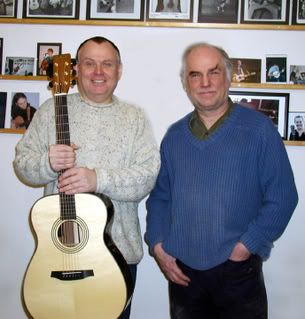
Now that I'm home, I'm looking forward to sitting down and spending some time with the new instrument - at present, work commitments have stacked up a bit and virtually all my time is taken up with writing; but heck, the weekend will soon be here and I'm aiming at grabbing some 'quality time' for me and the Falstaff. Here's a pic of her in my living room...
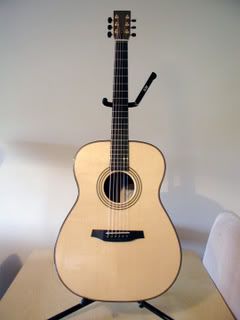
As I say, I haven't had too much time to sit and play so far, but initial noodlings have revealed a good, bright, well-balanced tone which is both sweet and profound. The harmonics are crystal clear and the sustain goes on forever. In short, I'm happy.
Before too long, I'm going to be in the studio again and I'll make sure that there's an MP3 of what the Falstaff sounds like available on the iTalk Guitar site so you can hear how sweetly she sings!
Last Tuesday (ie the 27th Jan) I went up to Penrith to collect the guitar and Roger treated me to a look around his workshop while I was there. Having been a guitar journalist for 17 years or so (and a guitarist for around twice as long) I have a great interest in how guitars are made and I must say the look around was fascinating - from the bare wood to the finished product in segmented stages. Great stuff - and I'm hugely indebted to Roger Bucknall for taking the time out to show me around.
Here's a pic of me with Roger in Penrith - grinning broadly having just had the Falstaff placed in my hands...

Now that I'm home, I'm looking forward to sitting down and spending some time with the new instrument - at present, work commitments have stacked up a bit and virtually all my time is taken up with writing; but heck, the weekend will soon be here and I'm aiming at grabbing some 'quality time' for me and the Falstaff. Here's a pic of her in my living room...

As I say, I haven't had too much time to sit and play so far, but initial noodlings have revealed a good, bright, well-balanced tone which is both sweet and profound. The harmonics are crystal clear and the sustain goes on forever. In short, I'm happy.
Before too long, I'm going to be in the studio again and I'll make sure that there's an MP3 of what the Falstaff sounds like available on the iTalk Guitar site so you can hear how sweetly she sings!
Thursday, 22 January 2009
Going Bespoke: The Finishing Line
The photostory of the master craftsmen at Fylde guitars making my new Falstaff acoustic is now complete with these three final pictures - although I will be posting a couple after I pick it up, no doubt!
This first picture shows the guitar awaiting its first set of strings...
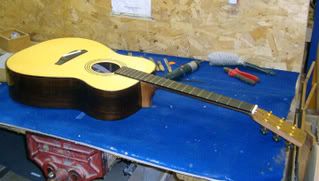
Once the strings have been put on, there is a bit of final adjustment to be carried out down at the nut...

Now, the guitar is ready for its first tune up. Obviously I've yet to hear it myself, but Roger Bucknall emailed me to say that it 'sounds lovely'.
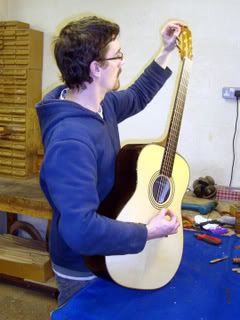
So there you have it - the making of a Fylde Falstaff acoustic guitar from the day the wood was chosen right up to the time when it's all strung up and ready to come out to play.
This first picture shows the guitar awaiting its first set of strings...

Once the strings have been put on, there is a bit of final adjustment to be carried out down at the nut...

Now, the guitar is ready for its first tune up. Obviously I've yet to hear it myself, but Roger Bucknall emailed me to say that it 'sounds lovely'.

So there you have it - the making of a Fylde Falstaff acoustic guitar from the day the wood was chosen right up to the time when it's all strung up and ready to come out to play.
Tuesday, 20 January 2009
Going Bespoke: The Final Straight!
Construction of my new Fylde Falstaff acoustic guitar is nearing completion and it's now time for the neck to be fitted. But first, some finishing touches: here, the body is receiving its final sanding.
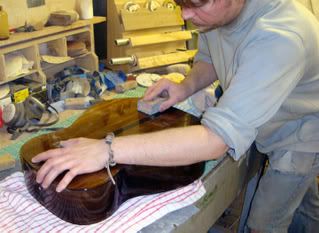
Next, the body is buffed to a shine...
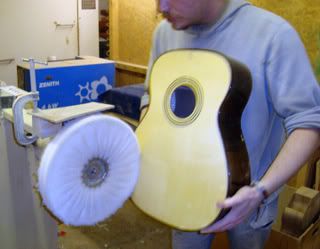
The neck, too, receives some final attention - after the sanding it received in the last crop of pictures, it's now being fine tuned with wire wool.
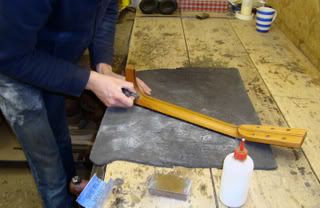
Now the really critical stuff begins... First of all, Roger removes the lacquer from the body in the places where the bridge and fingerboard will be glued in place.
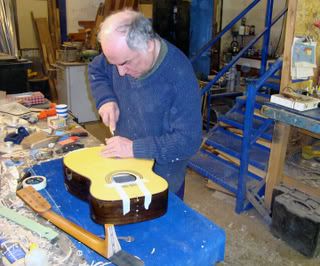
I must say, I really love this next picture - a sort of guitar-orientated still life!
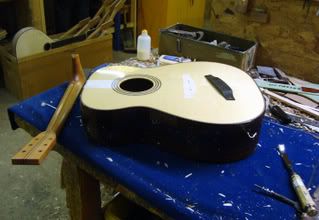
Now Roger makes the final adjustments to the heel of the neck before it's fitted.

After fitting, the fingerboard and bridge are both clamped in order to let the glue dry thoroughly.
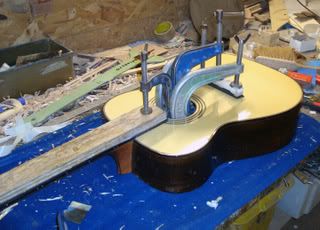
And lastly, the frets are added.
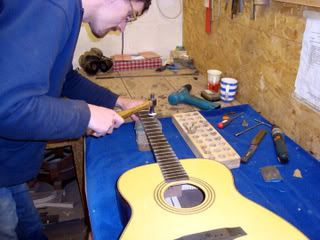
You can see from the picture above that I'm not having any fretboard markers fitted. To many, this represents 'flying blind' but I think it makes the guitar look nicely understated. Classical guitars don't have markers on the fingerboard and I have always liked that look. It might take a bit of getting used to, but I've always got the dots along the side to keep me in the right place.
I'll be picking the guitar up next week - there might be one more batch of pictures to come before then, but they'll certainly be some afterwards!

Next, the body is buffed to a shine...

The neck, too, receives some final attention - after the sanding it received in the last crop of pictures, it's now being fine tuned with wire wool.

Now the really critical stuff begins... First of all, Roger removes the lacquer from the body in the places where the bridge and fingerboard will be glued in place.

I must say, I really love this next picture - a sort of guitar-orientated still life!

Now Roger makes the final adjustments to the heel of the neck before it's fitted.

After fitting, the fingerboard and bridge are both clamped in order to let the glue dry thoroughly.

And lastly, the frets are added.

You can see from the picture above that I'm not having any fretboard markers fitted. To many, this represents 'flying blind' but I think it makes the guitar look nicely understated. Classical guitars don't have markers on the fingerboard and I have always liked that look. It might take a bit of getting used to, but I've always got the dots along the side to keep me in the right place.
I'll be picking the guitar up next week - there might be one more batch of pictures to come before then, but they'll certainly be some afterwards!
Thursday, 15 January 2009
A Game Of Two Halves...
Over the past few weeks, we've been spying on the manufacture of my new Fylde Falstaff acoustic guitar. When we left it last, the body was enjoying multiple coats of lacquer - a lengthy process because obviously it has to be allowed to dry after each coat and I understand that there is some sanding involved in between, too.
Well, I'm pleased to report that the body has now received its full complement of lacquer and is nearly through the final 'resting' period where the last coat has to dry out thoroughly before the next process can begin. So here it is - one half of my new Falstaff, all dressed up and shiny, awaiting the time when it will be introduced to the neck...
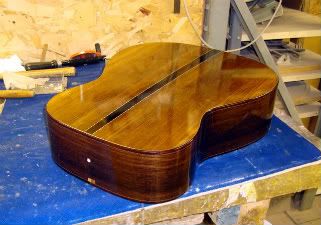
Talking about the neck, the last time we checked in, it was being shaped by Roger. Now, the final sanding process is being applied before it receives a coat or two of satin lacquer. This has the effect of giving the neck a slightly 'worn in' feel from the start - a high gloss finish on the back of a guitar neck might look great (although, let's face it, who gets to see it?) but there is a noticeable 'drag factor' on the hand. Guitarists (a funny bunch at the best of times) generally agree that a neck which has seen some action usually feels a little more user-friendly.
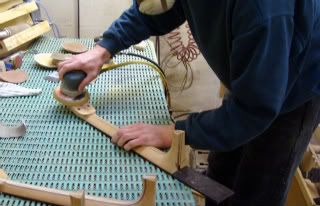
I'm told that these two halves are going to meet very soon - the neck will be attached to the body and the bridge put in place. Then the frets, pick-up and final trimmings will be sorted out and... Well, then I'll be driving up to Penrith to pick it up quicker than you can imagine!
Well, I'm pleased to report that the body has now received its full complement of lacquer and is nearly through the final 'resting' period where the last coat has to dry out thoroughly before the next process can begin. So here it is - one half of my new Falstaff, all dressed up and shiny, awaiting the time when it will be introduced to the neck...

Talking about the neck, the last time we checked in, it was being shaped by Roger. Now, the final sanding process is being applied before it receives a coat or two of satin lacquer. This has the effect of giving the neck a slightly 'worn in' feel from the start - a high gloss finish on the back of a guitar neck might look great (although, let's face it, who gets to see it?) but there is a noticeable 'drag factor' on the hand. Guitarists (a funny bunch at the best of times) generally agree that a neck which has seen some action usually feels a little more user-friendly.

I'm told that these two halves are going to meet very soon - the neck will be attached to the body and the bridge put in place. Then the frets, pick-up and final trimmings will be sorted out and... Well, then I'll be driving up to Penrith to pick it up quicker than you can imagine!
Wednesday, 7 January 2009
Going Bespoke: The Neck
When we left my new Fylde guitar before the holidays, the neck was really just a Honduras Mahogany club sandwich - a single piece of wood, sliced into three and glued together with some black dyed boxwood inserts, awaiting the insertion of its truss rod...
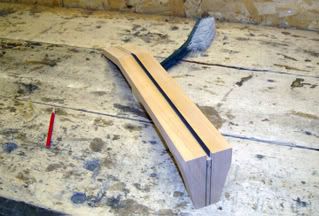
Seeing as the instrument's body is currently at the beauty salon, enjoying multiple coats of lacquer, work has been focused on transforming the neck into a much more familiar shape. Firstly, it is 'rough shaped' (notice, incidentally, that the truss rod has now been inserted and the fingerboard is in place).
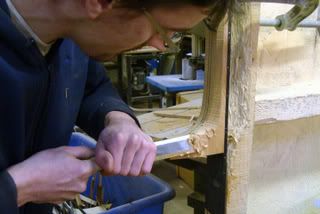
Here's one we made earlier... This is what the neck assembly looks like now that it has been rough shaped. It's now ready for fine-tuning and this is something that Roger Bucknall does the traditional way - by hand, employing craft, experience and, he tells me, a lot of love!

First, the heel is cut to shape...
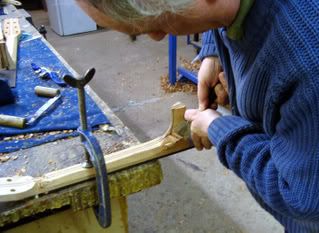
As is the headstock...
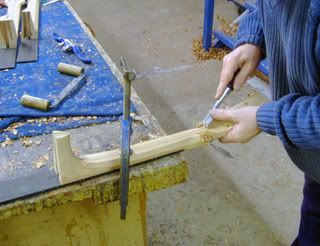
Then the neck itself comes under the knife - a drawknife, to be precise. In a world where most guitar necks are shaped by machine - using CAD technology in some instances - it's great to see this level of craftmanship going into an instrument. Having played virtually the whole Fylde range, I can tell you that their necks are some of the most comfortable and natural feeling I've ever experienced. Just the right width with a very subtle 'V' that sits nicely in the gap between the left hand thumb and forefinger...
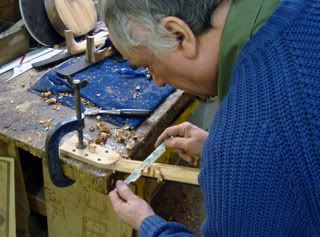
So there you have it - pretty soon the fingerboard will be fretted and the neck attached to the body, the bridge will be put into place and the final fittings will be added. There's probably no need to tell you that I literally can't wait to make some music with this new instrument!

Seeing as the instrument's body is currently at the beauty salon, enjoying multiple coats of lacquer, work has been focused on transforming the neck into a much more familiar shape. Firstly, it is 'rough shaped' (notice, incidentally, that the truss rod has now been inserted and the fingerboard is in place).

Here's one we made earlier... This is what the neck assembly looks like now that it has been rough shaped. It's now ready for fine-tuning and this is something that Roger Bucknall does the traditional way - by hand, employing craft, experience and, he tells me, a lot of love!

First, the heel is cut to shape...

As is the headstock...

Then the neck itself comes under the knife - a drawknife, to be precise. In a world where most guitar necks are shaped by machine - using CAD technology in some instances - it's great to see this level of craftmanship going into an instrument. Having played virtually the whole Fylde range, I can tell you that their necks are some of the most comfortable and natural feeling I've ever experienced. Just the right width with a very subtle 'V' that sits nicely in the gap between the left hand thumb and forefinger...

So there you have it - pretty soon the fingerboard will be fretted and the neck attached to the body, the bridge will be put into place and the final fittings will be added. There's probably no need to tell you that I literally can't wait to make some music with this new instrument!
Subscribe to:
Posts (Atom)
